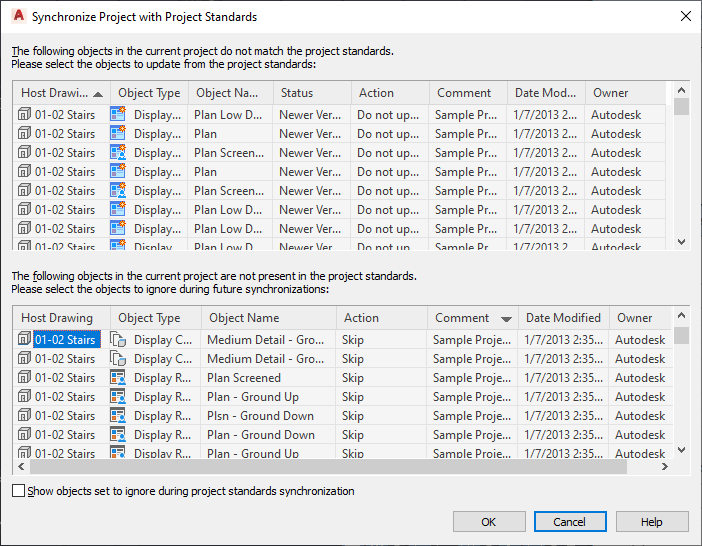When you have set up AEC project standards and enabled them, you can synchronize the project with the standards.
Synchronizing a project will synchronize all drawings contained within. Depending on your system setup and project size, this might take some time. Also, project drawings that are open during the synchronization might not be correctly synchronized because they will not be able to be saved after the synchronization. In that case, the drawings need to be closed, and the synchronization repeated.
- Verify that the project you want to synchronize is the current project.
-
Click


 .
.

Synchronizing a project with AEC standards
The synchronization dialog box is displayed with two lists. The top list shows styles and display settings that are either older versions of standard styles or display settings, or nonstandard (newer) versions. The bottom list shows a list of not standardized styles and display settings. For a definition of terms, see About Project Standards Terminology.
- To synchronize a style or display setting that is either an older version or a nonstandard (newer) version, select Update from Standards from the Action drop-down list.
- To skip over a style or display setting that is either an older version or a nonstandard (newer) version, select Do not Update from the Action drop-down list.
In this case, the nonstandard version remains in the project drawing for now, and is not updated with the standard. The next time the drawing is synchronized, the style or display setting will be listed again as inconsistent with the standard.
- To ignore a style or display setting that is inconsistent with the standard, select Ignore from the Action drop-down list.
In this case, the inconsistent object will not be listed again in future synchronizations, except if you select Show objects set to ignore during project standards synchronization, or remove the Ignore flag from the style or display setting in Style Manager or Display Manager, as described in To Exclude Styles and Display Settings From Synchronization.
Danger: You should use the Ignore option only in clearly defined exception cases where you are sure that a style or display setting does not need to conform to the project standards. - To skip over a not standardized style or display setting, select Skip from the Action drop-down list.
The next time the drawing is synchronized, the style or display setting will be listed again as not standardized.
Note: You cannot promote not standardized styles and display settings to standard ones here. To do this, you need to add the not standardized style to the project standards, as described in To Add Standard Objects From a Project Drawing to a Project Standards Drawing. - To ignore a not standardized style or display setting, select Ignore from the Action drop-down list.
In this case, the not standardized object will not be listed again in future synchronizations, except if you select Show objects set to ignore during project standards synchronization, or remove the Ignore flag from the style or display setting in Style Manager or Display Manager, as described in To Exclude Styles and Display Settings From Synchronization.
- Click OK.